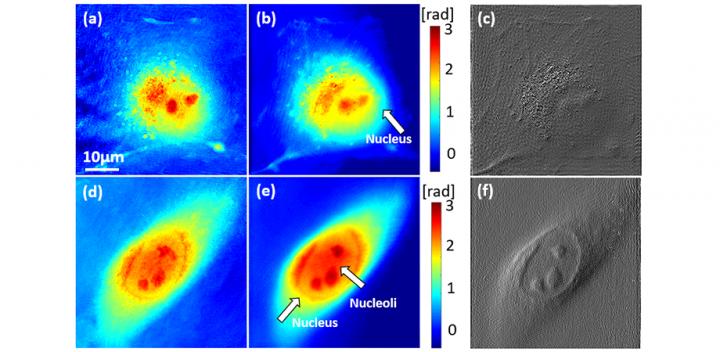A phase microscopy method with unprecedented spatial resolution and speed, enough to observe subcellular dynamics and nanometric structures

Credit: SPIE
Microscopy is an essential tool in multiple research fields and industries, such as biology, medicine, materials science, and quality control, to name a few. Although many microscopy techniques exist, each has pros and cons, mostly in terms of spatial resolution, speed (images per second), and applicability. For example, scanning electron microscopy can capture images with nanometric resolution, but it offers lower speed and is impractical for certain samples. Other simpler light-based microscopy techniques, such as fluorescence microscopy, are not suitable for visualizing living cells or other small structures because these are generally transparent and thin, which results in low light absorption.
Scientists have developed a technique called synthetic aperture microscopy (SAM), which makes use of an intrinsic property of light, called phase. This property refers to the relative delay between two electromagnetic waves. When light waves pass through a target sample, their relative phases change differently according to the optical properties at each point in the sample and the incident angle of the light. In SAM, multiple phase images can be taken in quick succession with different incident angles. These images are then processed and combined to form a crisper picture.
Although SAM is undoubtedly a promising approach, current implementations lack in both spatial resolution and frame rate to be useful for emerging applications. To address these issues, a team of researchers led by Renjie Zhou from The Chinese University of Hong Kong recently developed a novel SAM method. In their study, published in Advanced Photonics, the team presents an innovative setup for SAM imaging based on digital micromirror devices (DMDs).
DMDs are electronic components widely used in commercial digital projectors. They have a matrix of micromirrors whose orientation can be individually and electronically controlled at high speeds. Using two DMDs and appropriate lenses, the researchers devised a scheme in which the angle of a laser beam reaching the sample can be changed thousands of times per second. Once the light has gone through the sample, it is combined with a portion of the original laser to produce a light pattern known as an interferogram, which carries the phase information. To create the final phase image, multiple interferograms for different incident angles are combined using specially designed algorithms.
The researchers tested their novel method using various types of samples, such as nanometric gratings, red blood cells, and cancer cells. The results were very promising across the board, as Zhou remarks, “Using our DMD-based approach, we could accurately image material structures with features as small as 132 nm, quantify millisecond fluctuations in the membranes of red blood cells, and observe dynamic changes in cellular structure in response to exposure to chemicals.” This technique is also label-free, which means that one can observe living cells without harming them with fluorescent chemicals.
Another notable advantage of this new method is the cancellation of laser speckle, a type of unwanted interference that occurs when illuminating a sample with a laser. The use of multiple interferograms to compute one image irons out the random contributions of speckle in each interferogram, making the final composite image crisper. Moreover, one can increase the imaging frame rate as needed by using a lower number of interferograms, as long as the desired image quality is reached.
Zhou believes their SAM method could be a game changer in various fields where microscopy is essential, “We envision that our high-speed imaging technique will find applications in biology and materials research, such as studying the motions and interactions of live cells and monitoring material manufacturing processes in real time for quality control purposes.” He also notes that there is room for improvement in terms of speed by using even faster cameras, and that the underlying principles of their approach could be adapted with different algorithms to build a 3D imaging system.
###
Read the original research article: C. Zheng et al., “High spatial and temporal resolution synthetic aperture phase microscopy,” Adv. Photon. 2(6), 065002 (2020). doi: 10.1117/1.AP.2.6.065002
Related Content:
The PI on this study, Renjie Zhou, will give a presentation on this research during the upcoming free Advanced Photonics Colloquium, January 12-14. Review the program and register.
Media Contact
Daneet Steffens
[email protected]
Original Source
https:/
Related Journal Article
http://dx.




